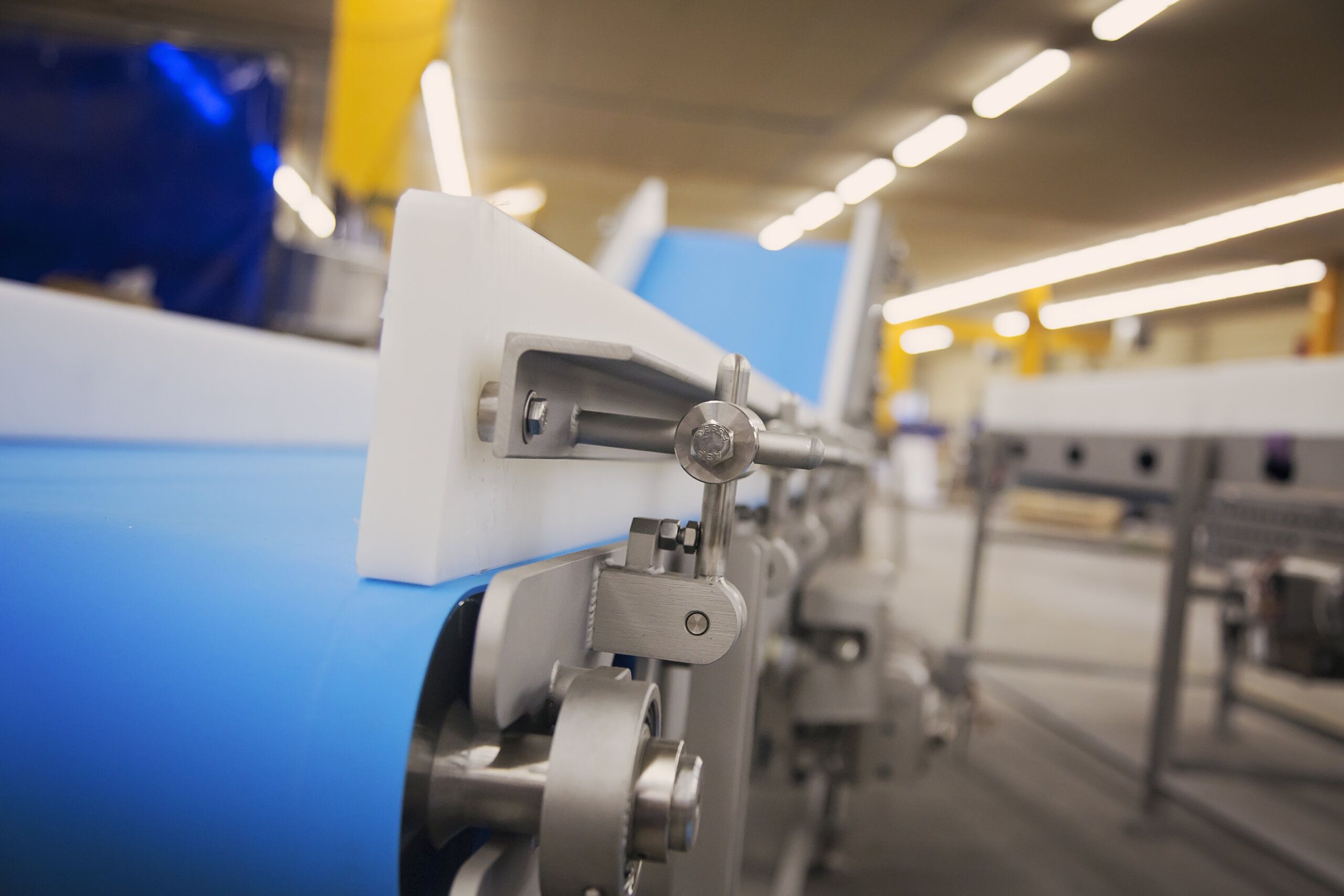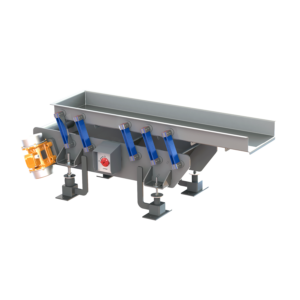
Blog
Conveyors: Critical to Food Safety in Processing Plants
Your plant’s conveyors touch food at every point of production from receiving to packaging, and before and after critical processing stages like slicing, thawing, pasteurizing, and cooking.
That makes your conveyor equipment a crucial part of your plant’s food safety infrastructure.
We take a look at how today’s food-grade sanitary conveyors are built to protect both consumers and your business from bacterial contamination that can cause foodborne illness.
We’ll examine what sanitary conveyors do and explain how they contribute to food processing plant safety. We’ll also consider some of the direct and indirect costs to your business of a food recall and the ever-tighter sanitary regulations that processors need to meet.
We’ll also look at some specific ways that well-designed and well-implemented food-grade conveyor systems can help ensure safety on your processing line. Read on to learn more.
SANITARY CONVEYORS AND FOOD-PROCESSING PLANT SAFETY
Conveyors move ingredients and product between processing stages in any production plant. They ensure the different applications in your plant are integrated into a single process and automate handling challenges like lifting, lowering, or reorienting product for further processing.
In food manufacturing, conveyors are critical to allowing large amounts of product to be processed quickly and efficiently, but they also perform another crucial function: your conveyor equipment needs to maintain the same food hygiene standards as the rest of your plant.
SANITARY CONVEYORS AND FOOD SAFETY
Bacterial contamination is the most serious threat to food safety, especially where consumable products are being handled in bulk. Harmful bacteria can grow quickly if food becomes trapped or equipment is not properly sanitized and can spread quickly through any exposed product.
Food-grade conveyor equipment is designed to avoid contamination of your product.
Modern conveyor food processing systems include food-safe components and special features designed to maintain hygiene to both prevent dangerous bacteria from contaminating your product and limit its ability to spread.
![]()
However, sanitary conveyor equipment also helps protect your product by:
- Limiting the time that food is exposed to potential contamination
- Combining and reducing processing steps to minimize handling
- Matching handling techniques to your specific product.
Today, food-grade conveyors provide effective sanitary control while offering a full range of sanitary handling solutions that can be customized to the needs of your product or the constraints of your production space. These include:
- Belt conveyors for flexible, seamless line integrations
- Bucket and incline conveyors for raising product in motion
- Tote dumpers for safe, efficient bulk handling
- Horizontal motion conveyors for loose or granular products
- Vibratory conveyors for efficiency, value-added sanitary conveying
THE REAL COSTS OF FOOD CONTAMINATION
Food-safe solutions designed with your product and process in mind are critical when you consider the real cost of a food safety failure or product recall.
The CDC estimates that sicknesses caused by food-borne pathogens affect 48 million Americans every year, with up to 128,000 people being hospitalized by bacterial pathogens such as campylobacter, listeria, salmonella, and E. coli.
Beyond the seriousness of causing your product’s consumers to become ill, increasingly sophisticated industry monitoring means manufacturers are subject to ever-higher hygiene standards and more sophisticated contamination tracing techniques.
Today, even a limited product recall can cost your company up to $10 million. The cost of downtime and lost product of a complete line shutdown to deep clean, sanitize, and test equipment can be far higher.
In addition, the indirect costs to your business can be hard to measure but just as real. Among other things, these can include:
- Damage to your brand
- Damage to your company’s reputation
- Loss of public confidence in your product category
- Loss of key staff
- Lower workforce morale
MEETING TODAY’S FOOD SAFETY STANDARDS
To minimize the risk to consumers and the food system as a whole, regulators and industry groups require food processing equipment, including sanitary conveyors, to meet a wide range of standards. Common standards in the U.S. today include:
- Consumer Brands Association (CBA) — (formerly Grocery Manufacturers Association)
- American Bakers Association (ABA)
- North American Meat Institute (NAMI)
- USDA
- FDA
- ISO 22000
Compliance with these standards is enforced by regular equipment inspections and testing for processors falling into particular industries or product categories. Typically, any food-exposed surface needs to pass a rigorous surface-swab test to meet sanitary requirements.
Safety standards are also constantly improving. For example, the FDA Food Safety Modernization Act is being rolled out and will raise standards significantly in several sectors.
The best equipment already exceeds current standards to help ensure your process continues to comply with advancing food safety requirements for years to come.
HOW DO SANITARY CONVEYORS IMPROVE FOOD SAFETY?
Let’s take a look at how today’s food-grade conveying equipment works to protect food safety, including good design, practice principles, and specific technologies.
1. Minimizing Handling
Perhaps the most significant contribution conveyors make to food safety is to minimize the amount of physical handling that your product receives. By reducing the need for human contact with food in order to move product between processes, a major source of contamination is removed.
The ability of different types of conveyors to move, raise, lower, and change the direction of travel means the need for human handling of food is often eliminated entirely. Some, like horizontal motion conveyors, can even slow down or reverse direction to allow parts to be cleaned or replaced without stopping the line.
2. Matching Technology to Process
Choosing the right conveyor for your product or process is critical to maintaining a consistent level of hygiene. For example, vibratory conveyors are best for preventing the sticking of cooked food, while horizontal motion conveyors keep frozen product like seafood moving.
![]()
While many smaller operators may be tempted to choose standard off-the-shelf conveyor equipment that seems to meet their needs, seasoned, at-scale producers usually prefer to work with an experienced equipment provider who can match conveyor equipment to their needs.
3. Sanitary Materials
The best food-grade conveyor equipment is made from high-quality sanitary materials. To minimize the risk of contamination, any surface that comes into contact with food must be:
- Smooth and free of cracks, crevices, or dents
- Nonporous and nonabsorbent
- Non-reactive to food products
- Corrosion resistant
- Requires little or no maintenance to maintain these characteristics.
This applies particularly to painted, coated, or electroplated surfaces. Here there should never be any flaking, bubbling, or chipping of food-exposed surfaces.
Instead, to preserve hygiene, most leading brand manufacturers of sanitary conveyors choose either FDA-approved food-grade plastics for belting or bucket systems and a range of metals for contact surfaces, depending on the application.
| Metal | Characteristics / Uses |
| Stainless Steel | Materials of choice for quality sanitary food conveyor equipment:
|
| Titanium | Superior strength and corrosion resistance but very expensive:
|
| Copper | Durable but susceptible to leaching when exposed to high-acid foods.
|
| Carbonized metal & cast iron | Tough, heavy materials used only for direct cooking surfaces and frying equipment. |
| Aluminum | Lightweight metal susceptible to corrosion.
|
While a range of metals might be appropriate for applications handling dry materials like hard candy or pasta, dairy, and meat processors must meet much tighter sanitary standards.
Here, true food-grade stainless steel is preferred for its naturally antimicrobial properties and resistance to high-temperature wash-down, pasteurization, and sterilization procedures.
4. Designed for Safety
There’s more to building true professional-grade food conveying equipment than just choosing the best materials. Leading equipment is distinguished by smart design thinking about sanitation, often based on years of industry experience.
Minimal Moving Parts
Keeping machinery simple makes equipment easier to keep clean, maintain, and sanitize.
- Reduces wear and tear to minimize downtime and maintenance calls
- Fewer connections and other potential contamination points
- Key components are easier to access for cleaning and maintenance
- Simplifies sanitation and validation processes
Making equipment simpler also enables the toolless replacement of key components, reducing the likelihood of damage or contamination of your line by non-sterile maintenance tools.
Active Water and Condensation Management
The best equipment is designed to minimize moisture accumulation and actively manage liquids released by cooking, draining, and dewatering. Look for:
- Angled surfaces
- Tilted or grooved belts and conveyor surfaces
- Self-draining piping systems
Water Ingress Control
For equipment exposed to high-temperature washdown and sterilization processes, such as conveyors handling dairy or raw meat products, look for features that seek to minimize water ingress between components. Look for:
- Solid stainless steel tubing
- Minimal unwelded joints, crevices, or fasteners
- IP69K compliance: the top industry standard for limiting water ingress between parts
Minimized Bacteria Harboring Opportunities
Simple design, premium materials, and quality construction all help to minimize food-exposed places where bacteria could build up. They also make it easier to swab-test and validate equipment. Look for:
- Properly designed and installed fasteners
- Tight, overlapping joints and connections
- Smooth, polished welds and well-milled contact surfaces
- Radiused corners without welds
Also, be sure to look beyond direct contact surfaces when checking for harboring opportunities. Look carefully at the top edges and contact points with coverings or lids where moisture or waste could accumulate.
WHAT IS VALUE-ADDED SANITARY CONVEYING?
In addition to these industry-standard features, leading equipment providers offer technologies or features that add value to your food safety investment above that offered by standard sanitary conveying equipment. Here are some ways value-added sanitary conveying is achieved:
 1. Combining/Eliminating Processes
1. Combining/Eliminating Processes
Advanced equipment like PFI’s Magnaflex and VFII vibratory conveyors offers value-added processing that allows product to be laned, spread, de-watered, or reoriented while in motion, allowing the ability to combine or eliminate processes that were previously separate steps.
Fewer steps mean less overall handling or exposure time for vulnerable materials like sliced fresh produce, raw meats, or cheeses.
2. Improved Quality Control
Variable-speed horizontal motion conveyors allow finished products to be more easily inspected on moving trays prior to final packaging, thereby improving the quality of your output and allowing more opportunity to spot substandard product.
3. Clean-in-Place
Premium conveying equipment is generally customized for your specific application and may include option features, such as clean-in-place equipment. This allows food-exposed surfaces to be cleaner or to self-clean while the machine is still in operation.
Value-added equipment like belt scrapers, flip-down guarding, belt lifts, and quick-release take-ups minimize hands-on maintenance, helping to ensure sanitary conditions for longer.
PFI: INDUSTRY-LEADING SAFETY, VALUE-ADDED FEATURES
There’s no room for compromise when it comes to the safety of your product. PFI Conveyors is the recognized leader in supplying high-quality sanitary equipment that is the preferred choice of many of America’s most recognized food brands. Trust PFI to deliver:
- Industry-leading know-how: With over 60 years of experience in almost every food processing vertical, we have the right technology for your process.
- Better conveyor design: We are the recognized leaders in sanitary conveyor design. We offer fully customized, value-added solutions to tough food safety challenges.
- Unparalleled service: We back our conveyors with our collaborative problem-solving approach of full-scale testing and ongoing support. We also install all of our products.
At PFI, we are committed to helping you find the best sanitary conveying solution for your needs and to working with you at every stage of the design and delivery process.
Click below to learn more about how investing in quality and safety upfront pays dividends over time. Contact us today to discover how we can put our unparalleled skills and experience to work for you.
10 Factors That Affect the Price of a Sanitary Conveyor System
Quicklinks
© 2024 PFI. ALL RIGHTS RESERVED. | Privacy Policy | Terms and Conditions




